Trezor Model One review
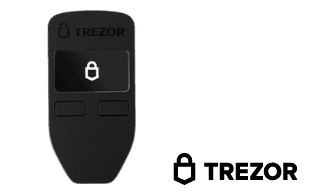
- Supported assets
- 9,000
- Price (USD)
- $59
- Wallet type
- Hardware wallet
Summary
Touted as the "original hardware wallet," we take a look at whether the Model One still stacks up.Finder.com's rating: 3.5 / 5.0
★★★★★
- Good for storing the keys to major crypto assets offline.
- Not so good for its supported coin range.
Pros
-
Supports 9,000+ crypto assets
-
Easy-to-use native Trezor Suite interface for your desktop
-
Can trade crypto to crypto using Trezor Suite
-
Can store private keys to NFTs on Ethereum
-
Can use MoonPay in conjunction with Model T to purchase crypto with fiat
-
One of the most affordable hardware wallets on the market
Cons
-
Small number of blockchains supported
-
Doesn't support some major cryptos like SOL, ADA and XRP
-
Doesn't support iOS
-
Doesn't work well with Chromebooks
-
No native staking support or support for NFTs in Trezor Suite
Disclaimer: This page is not financial advice or an endorsement of digital assets, providers or services. Digital assets are volatile and risky, and past performance is no guarantee of future results. Potential regulations or policies can affect their availability and services provided. Talk with a financial professional before making a decision. Finder or the author may own cryptocurrency discussed on this page.
The Trezor Model One is the original cryptocurrency hardware wallet. It's a small device for securely storing the private keys to your digital assets in cold storage – offline and physically separated from your computer.
To make transactions using the device, it must be connected to your computer and you must download the device's native Trezor Suite software for your desktop.
The Model One is all you need to manage major crypto assets like Bitcoin (BTC) and Ether (ETH). But it doesn't offer as many coins and features as some of its competitors, including Ledger's Nano S Plus model.
Model One pros and cons
Pros
- Supports 9,000+ crypto assets
- Easy-to-use native Trezor Suite interface for your desktop
- Can trade crypto to crypto using Trezor Suite
- Can store private keys to NFTs on Ethereum
- Buy and sell crypto directly from your wallet
- One of the most affordable hardware wallets on the market
Cons
- Small number of blockchains supported
- Doesn't support some major cryptos like SOL, ADA and XRP
- Doesn't support iOS
- Doesn't work well with Chromebooks
- No native staking support or support for NFTs in Trezor Suite
What's in the box?
You'll find the following items in the box for the Trezor Model One:
- A Trezor One device
- USB-A to Micro USB cable
- Keychain with strap
- 2 recovery seed phrase cards (with lines for 24 words on each)
- Instruction booklet
- 4 stickers
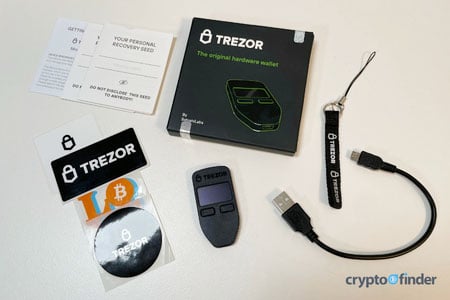
⚠️ Must read: Check for tampering
Before unboxing your Trezor Model One, carefully check the shrink wrap and the box itself for any evidence of tampering.
Once you open the box, make sure that the holographic sticker over the USB input for the Trezor device itself hasn't been tampered with. If someone has accessed your device, it may be vulnerable to hacking and theft of funds.
Contact Trezor support if you have any concerns about the integrity of your device.
Trezor Model One price
The Trezor One sells for US$59 through Trezor's official website.
This makes it much cheaper than Trezor's flagship hardware wallet, the Trezor Model T, which retails for US$129.
Its cost is about on par with Ledger's base mode hardware wallet – the Ledger Nano S Plus – which retails for US$79.
Where to buy the Trezor One in the US
Purchase the Trezor One directly from Trezor's website – and not from a third party – to reduce the chances of someone tampering with your device before it reaches you.
Trezor lists some authorized resellers that sell the Trezor One on its site. If you decide to buy from a reseller, these are the only ones that you should consider.
Trezor One supported coins
The Trezor One can store private keys to 9,000+ digital assets. This is fewer assets than the Trezor Model T supports (1,000+).
It's also far less than the 5,500+ digital assets that a comparable wallet like the Ledger Nano S Plus supports.
Importantly, the Trezor One doesn't support major blockchains and crypto assets including Binance Smart Chain (BNB), Cardano (ADA) and Ripple (XRP).
Managing NFTs on the Trezor One
You can store the private keys to your NFTs on the Ethereum blockchain with your Trezor One.
But you won't be able to view or manage your NFTs using Trezor Suite. You'll have to sync your Model One with a third-party software wallet like MetaMask instead.
Purchasing and swapping crypto coins through Trezor Suite
You can now use MoonPay in Trezor Suite to purchase crypto with dozens of fiat currencies, including US dollars.
And if you want to swap your crypto, there's no need to send it from your Trezor One to an exchange. You can perform trades in Trezor Suite using a swap feature powered by Changelly, which allows you to swap coins and tokens across several blockchains.
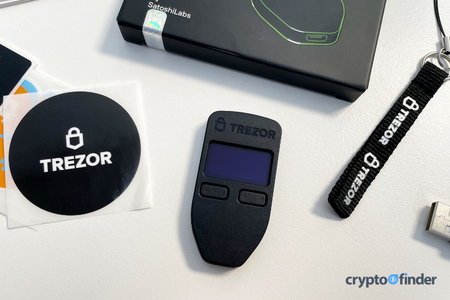
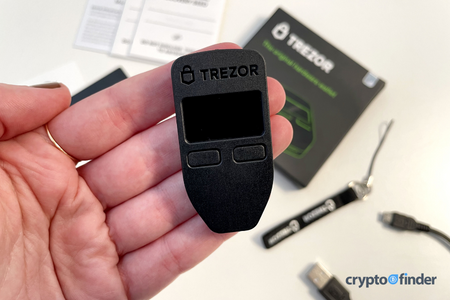
Trezor One security
Because the core technologies that Trezor employs are all open-source – including its physical hardware – anyone is able to review and test the code, which is posted on GitHub, in an effort to expose flaws.
In October 2019, crypto exchange Kraken found a flaw that made the wallet hackable if someone had physical access and the right set of tools. In response, Trezor made improvements to the future editions of its hardware wallets to eradicate the flaw.
While Kraken showed that previous versions of the Trezor One could hypothetically be hacked, there are no reports of a Trezor One purchased by a retail customer ever being compromized in this way.
Trezor specs compared
Both the Trezor One and the Model T help you to safely store the private keys to your digital assets offline.
The main differences between the Model One and Model T are the number of assets each hardware wallet supports, the physical features of the wallet itself, cost and advanced software features such as Shamir Backup.
| Trezor Model One | Trezor Model T | |
|---|---|---|
 Finder score
★★★★★ |
 Finder score
★★★★★Read full review |
|
| Dimensions | 60 x 30 x 6mm | 64 x 39 x 10mm |
| Display | 128×64px OLED screen | 240×240px LCD touch screen |
| Security mechanism | ARM Cortex-M3 embedded-arm processor @ 120Mhz | ARM Cortex-M4 embedded-arm processor @ 168Mhz |
| Security certifications | CE and RoHS certified (consumer safety, health and environmental health award | CE and RoHS certified (consumer safety, health and environmental health award |
| Connection | USB-A, WebUSB, Micro USB (for mobile) | USB-C (for mobile), WebUSB |
| Compatibility | PC (Windows 10+, macOS 10.11+ and Linux), Mobile (Android) | PC (Windows 10+, macOS 10.11+ and Linux), Mobile (Android) |
| Backup | 12-24-word seed phrase | 12-24-word seed phrase | Coin support | 9,000+ | 1,000+ |
| Staking | Yes, but only when linked to third-party wallets | Yes, but only when linked to third-party wallets |
| NFT management capability | ✅ | ✅ |
| Exchange built in to native software (Trezor Suite) | ✅ | ✅ |
| Price (USD) | $59 | $129 |
| Buy the Trezor Model One | Buy the Trezor Model T |
Trezor One vs. Ledger
While the Trezor One and Ledger devices serve the same primary purpose – storing the private keys to your digital assets offline – there are a number of differences between the devices including supported coins, cost and the physical device.
Our full breakdown of Trezor vs. Ledger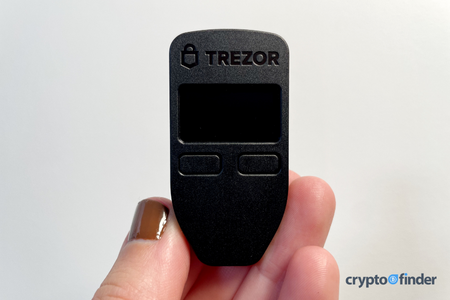
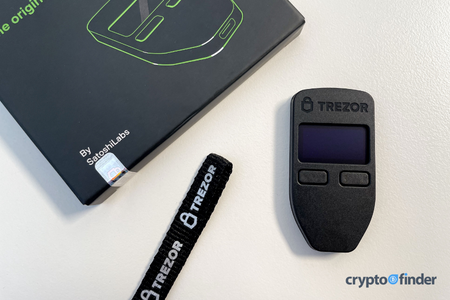
How to set up the Trezor One
Make sure that the shrink wrap around the box in which you receive your device, the box itself and the holographic stickers over the top and bottom openings of the box haven't been tampered with before setting up your Trezor One. Plastic wrapping can be removed and replaced easily, so pay extra care to the condition of the package and plastic seals, which are more likely to reveal evidence of tampering. If you suspect tampering, contact Trezor support for assistance.
Setting up a Trezor One is relatively quick and straightforward, with the device and on-screen prompts guiding you through the process.
Follow these steps to set up your Trezor One device:
- Go to https://suite.trezor.io/start/ on your desktop computer.
- Click the "Get Desktop App" button and download Trezor Suite for whatever desktop operating system you run. The Trezor One is compatible with Windows 10+, macOS 10.11+ and Linux.
- Connect your Model T to your desktop using the USB-A to Micro USB cord.
- Click the "Begin setup" button.
- Click the "Install firmware" button.
- Click the "Create new wallet" button.
- Verify the package by following the instructions in Trezor Suite.
- Follow the instructions on the device. Your device will generate a unique recovery seed phrase that will provide access to all of the digital assets that you manage with Trezor One.
- Click on the "Create backup" button and write down your 24-word recovery seed phrase on the specially designed cards for doing so that came with the device. Make sure to spell all of the words correctly and to write them in the correct order.
- Once you've confirmed that you've written all of the words down, your Trezor One will display the 24-word recovery seed again. Double-check the correct order and spelling of the words.
- Enter a PIN (recommended length: 4–6 digits) by clicking the obscured numerical pad in the browser. The layout revealing the position of your digits is displayed on your Trezor device.
- In Trezor Suite, click on the "Standard wallet" button and set this wallet as your initial and default wallet.
- You may also be prompted to give your Trezor One default wallet a name.
How to use the Trezor One
To use your Trezor One, you will use the Trezor Suite app on your desktop in conjunction with the device.
Connecting with Trezor Suite
Once Trezor Suite is open, follow these steps:
- Open the Trezor Suite app on your desktop.
- Plug your Trezor One into your desktop using the USB-A to Micro USB cable.
- Enter the PIN for your Trezor One.
- If you gave your Trezor One a name, you will need to confirm the name.
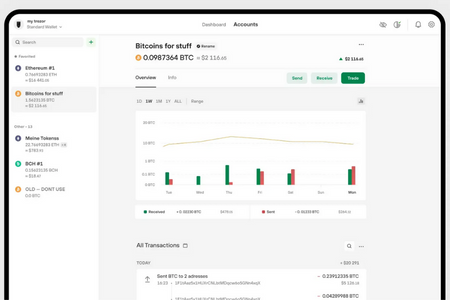
Alternatives to Trezor Model One
Our verdict
The Trezor One is a good entry-level hardware wallet for beginners.
As the original hardware wallet, it has a long track record of safely storing the private keys to digital assets offline.
But its features are limited when compared to a hardware wallet like the Ledger Nano S Plus, which retails for only a few dollars more than the Trezor One.
The Trezor One's native software – Trezor Suite – provides a user-friendly interface to help you manage your digital assets and even buy digital assets with fiat through MoonPay, but it doesn't allow you to stake your crypto nor view and manage your NFTs the way that you can on Ledger Live – the native software for Ledger products.
Safely storing the private keys to your digital assets is a very crucial part of investing in this asset class. Do your research on the best crypto wallets out there before you decide which is right for you.
Hardware wallets like the Trezor One are widely considered to be one of the safest ways to store the private keys to your crypto offline, especially if you are a crypto holder looking to invest for the long term.
Frequently asked questions
Hardware wallet ratings methodology
We rate cryptocurrency hardware wallets by scoring each wallet out of 10 for 3 components: security, functionality and cost. Each component is weighted based on importance, as follows:
- Security: 50%
- Functionality: 40%
- Cost: 10%
These scores are aggregated and visualized as a total score out of 5 stars.
Sources
Your reviews
Frank Finder
Writer
You are about to post a question on finder.com:
- Do not enter personal information (eg. surname, phone number, bank details) as your question will be made public
- finder.com is a financial comparison and information service, not a bank or product provider
- We cannot provide you with personal advice or recommendations
- Your answer might already be waiting – check previous questions below to see if yours has already been asked
Finder only provides general advice and factual information, so consider your own circumstances, or seek advice before you decide to act on our content. By submitting a question, you're accepting our finder.com Terms of Use and Privacy and Cookies Policy.
This site is protected by reCAPTCHA and the Privacy Policy and Terms of Service apply.
